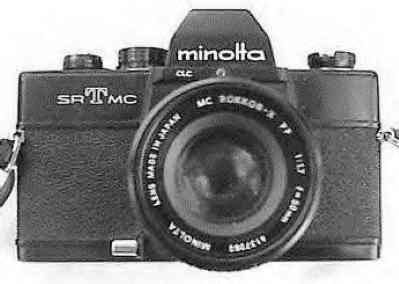
SRTMC
(1973) In 1973, Minolta was selling three manual exposure SLR cameras
-- the SRT102, the SRT101,
and the SRT100. Sales were doing very well
and the cameras were well-respected by consumers and professionals. As
a way to increase sales even more, Minolta decided to entered into special
agreements with large department stores in the US and Europe. In fact,
this was nothing new. For several years, Sears & Roebuck, for example,
had been selling a large number of cameras from numerous companies that were
re-badged as "Sears" or "Tower" cameras. These models were only available
in Sears stores and were identical, or nearly identical, to the models sold
directly by the camera manufacturers.
The Minolta SRTMC camera was a modified SRT100 /
SRT200 and sold by stores such as K-Mart. Just
as the SRT100 and SRT200
evolved over time, you'll see the same changes in the SRTMC. The model
is not inscribed on the cameras.
-
SRTMC -- (1973)

The original SRTMC retained the major features of the
SRT100:
-
TTL, full-aperture metering
-
CLC metering
-
DOF button
The SRTMC also lacked the major features that the
SRT100 lacked:
-
no mirror lock-up
-
no self-timer
-
no shutter speeds in the viewfinder

But the SRTMC added two features lacking in the
SRT100: a top shutter speed of 1/1,000 and
a hot shoe. The SRTMC was available in chrome or black.
-
SRTMC-II (model a) -- (1977)

In 1975, Minolta upgraded the SRT100 to the
SRT200. These changes made their way
into the SRTMC camera, and the SRTMC-II (model a) was born in 1977. This
was the same year that Minolta introduced the first of the XD and XG cameras,
and several of these features were copied directly from the XD and XG line.
Perhaps it was an attempt to make the older-styled cameras look as
similar as possible to the newer cameras, but it is just as likely that the
newer parts were available -- and useable -- on the older cameras. First,
there was a switch on the SRTMC-II (model a) to a black, plastic aperture
ring around the lens mount -- replacing an aluminum ring.
In addition, the locking DOF button of the earlier SRT cameras was replaced
with a non-locking DOF button. On the surface, this sounds like a minor cosmetic
change. But the change is more than skin deep. At the same time, Minolta
dropped the "meter off" switch which, in all previous SRT models, would
automatically turn the meter off when the DOF button was pressed (when an
MC lens was attached to the camera). The purpose of this early feature
was to allow metering in "stop-down" mode with early non-MC lenses. That's
why the DOF button on Minolta SLR cameras was originally called the
"stop-down-metering" button. So with this switch, Minolta was cutting out
a few cents in manufacturing costs -- and casting aside users of earlier
lenses.
Also, the SRTMC-II (model a) only had X synchronization for flash use --
the FP option of the SRTMC was dropped. The more important change was
that the focusing screen was updated to include a split-rangefinder in the
middle of the microprism circle and a self-timer was added. Look for
the CLC marking to identify the SRTMC-II (model a).

The SRTMC-II (model a) was available in chrome or black.
-
SRTMC-II (model b) -- (1979)

On this model, the mirror-lockup option was dropped. By this time,
Minolta knew it would never need to develop another recessed wide-angle lens.
They had developed super-wideangle lenses using new optical designs
that obviated the older recessed designs. Minolta knew that while their
older 21mm recessed wide-angle would not fit on this camera, they had designed
a new 20mm that didn't need the mirror lock-up device. Otherwise the
major features of this version of the SRTMC are the same. Look for
the missing CLC marking to identify the SRTMC-II (model b). This model
was only avalaible in chrome.
The SRTMC was sold up until 1980. Sears would continue to sell Minolta
cameras after that date, but none of the models would be modified for exclusive
sales by K-Mart. Because it is a less well-known SRT model, the SRTMC
often sells for very little, despite it's well-rounded features. For a
comparative look at the major features of the SRTMC models, check out
MINMAN's SLR table
-- the world's most complete!
RETURN TO THE MANUAL
MINOLTA HOME PAGE We didin't want to do this, but since other websites
have been stealing our stuff, we have no alternative but to
state:
COPYRIGHT@1995-2023 by
Joe McGloin.
All Rights Reserved. The material on this website is protected by US Federal
copyright laws. It cannot be copied or used in any manner without specific
approval from the owner.
The material on this website is protected by US Federal copyright laws. It
cannot be copied or used in any manner without specific approval from the
owner.






